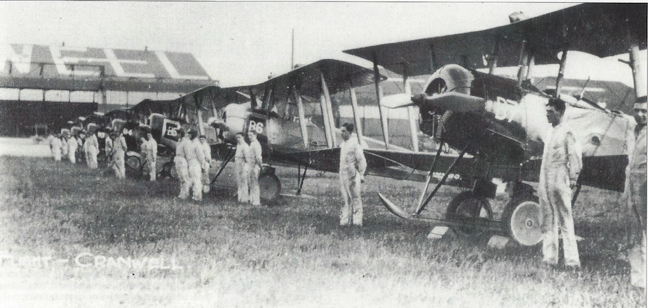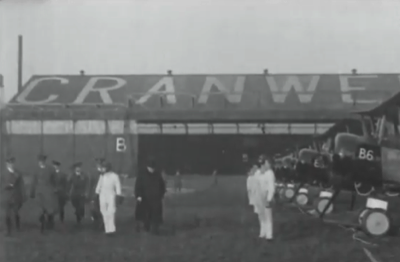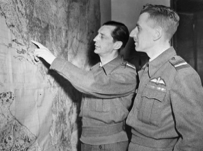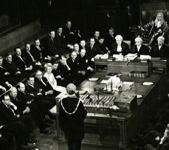Graduation Reviewing Officer
Commandant




Mortality
Of the 47 entrants who were commissioned 11 (23%) of these officers were subsequently
killed in action or in flying accidents.
Henry Beatty 18/2/1935 (see below and webpage)
George Bernard-Smith 10/12/1941 (webpage)
William Brook 17/9/1953 (see below)
Sylvanus Conolly 27/1/1936 (webpage)
Matthew Hayter 24/10/1922 (see below)
Noel Hayter-Hames 21/3/25 (see below)
Earnest Lacey 24/11/1931 (webpage)
Jasper Peck 3/3/1924 (see below)
Rupert Pontiflx 14/4/1925 (see below)
Robert Whelan 31/12/1927 (see below)
William Yale 4/9/1936
_________________________________
AVM Brook was to assume the post of Vice Chief of the Air Staff from September 1953 in the rank of Air Marshal. However, shortly before taking up his new appointment, he was killed. At the time he had been undertaking a jet conversion course at the Bomber Command Jet Conversion flight, RAF Coningsby and as part of this was carrying out a solo exercise in a Meteor. Near Stafford his aircraft was seen to suddenly turn and dive into a haystack, the haystack was set alight, the aircraft disintegrated and AVM Brook was killed instantly. The coroner returned a verdict of death by misadventure as no technical fault could be found, but was he possibly a victim of the Meteor’s design fault, subsequently discovered to be the cause of a number of crashes throughout its service career.
________________________________
Surrey Mirror - Friday 27 October 1922
FLYING OFFICER KILLED AT KENLEY.
Flying Officer F. Hayter, of the R.A.F., while flying at Kenley Aerodrome shortly after 4 o'clock on Tuesday evening, unaccountably nose-dived. The airman, apparently, lost control and the machine crashed from a great height, Hayter sustaining fatal injuries.
Surrey Mirror - Friday 03 November 1922
FLYING CRASH. PILOT OFFICER KILLED AT KENLEY.
While flying at Kenley Aerodrome, where he was under instruction, a young pilot officer, Mathew Charles Hayter, crashed with his machine from a height of 2,000 feet, and was instantly killed. The accident occurred on Tuesday afternoon last week, and was witnessed by a fellow officer who had just previously flown the machine.
An inquiry was held by the East Surrey Coroner (Mr. F. J. Nightingale) in the Medical Hut at the Aerodrome on Friday last.
Mathew Henry Hayter, of "Winchmore," Walkers-road, Stevenage, Herts, identified the body as that of his son, aged 21, a pilot officer in the Royal Air Force.
A witness of the fatal flight, Pilot Officer David Bett, R.A.F., gave evidence that the machine was flown by him just previously to deceased going up, and was in perfect order. In fact, the engine was running between the time of his landing to when Hayter took off. He was flying at a height of about 2,000 feet over the aerodrome when witness saw him get into a spin and crash.
The Coroner: Did it appear to you that he did anything unusual?
Witness: Yes. He attempted to turn without sufficient speed.
The Coroner: That in your opinion was the cause of the crash?
Witness: Yes.
Flight-Sergt. James Holden, R.A.F., part of whose duty it was to inspect the machines and certify them air worthy, said that particular 'plane was sent up on a test flight the previous day, when the testing officer, Flight-Lieut. Luxmore, passed it as "O.K." In the morning he noticed the propeller rubbing against the doors of the shed, but only the metal tipping was scratched, and new "prop" was substituted.
The Coroner: That is all?
Witness: Yes.
The Coroner : Then prior to this test flight it was all in order?
Witness: Yes.
Flight-Lieut. Francis L. Luxmore, R.A.F., said he tested the machine on Monday morning, and again on Tuesday, when it was taken out for the pupils to fly. It was absolutely air worthy in every respect, and prior to deceased going up had been out on six flights that day - three in the morning and three in the afternoon.
Elijah Brown, medical officer at the aerodrome, said the cause of death was fractured base of skull. Both legs, left thigh, and left arm were also fractured.
Recording a verdict of "Accidental death," the Coroner remarked that he was satisfied that proper precautions were taken as regards testing the machine.
________________
F/O Noel Hayter-Hames No.27 Squadron.
Shot down and killed during a bombing raid and his Airco DH.9A which caught fire. Waziristan, India.
21/3/1922
_____________
Flt Lt Henry BEATTY, Henry Longfield, 15 February 1935 at San Filippo, Sicily in the crash of
a Short Singapore III (K3595), on charge of No.210 Squadron, being delivered to No.205 Squadron,
crashed into mountainside near Messina in bad weather.
This was one of four aircraft which had left Pembroke Dock on 15 January 1935 en route to Singapore.
________________
F/O Rupert PONTIFLEX - Killed 18 April 1925 in air operations in Iraq; believed shot down by rifle fire.
________________
F/O Robert Darley WHELAN, - Killed 3 December 1927 in a Fairey Fox of No.12 Squadron, Andover, with 357736 AC2 Henry Arthur Lacey
________________
F/O Jasper Godfrey PECK,- Killed 3 March 1924 at Duxford as a result of a collision in the air; passenger in a two-seater Snipe (pilot was F/L V.A. Albrecht) which collided with an Avro piloted by Sergeant G.T. Bond (killed, P/O W.A. Tattersall injured).

Akerman Walter A Imperial Service College Windsor
Barrett James B Truro Cathedral College
Beatty Henry B Osborne Dartmouth
Bernard-Smith George B Sherborne
Bonham-Carter Donald A Winchester
Boyd Eric B Wellington
Brook William A Rugby
Brookman Herbert B Osborne Dartmouth
Brown John A Eaglehurst College
Burton Edward A Osborne Dartmouth
Collingwood Cuthbert A Osborne Dartmouth
Combe Gerald A King's College, Wimbledon
Conolly Sylvanus B Adams GS, Newport
D'Aeth Narborough B Osborne Dartmouth
David Edward B Wellington Dartmouth
Desmond Thomas A Presentation College, Cork
Drabble John A Osborne Dartmouth
Falconer Colin B Edinburgh Academy
Foote Henry A Tonbridge
Forster Edward A Christ's Hospital, Horsham
Garnons-Williams A Osborne Dartmouth
Gay George A Westminster
Gore Charles B Imperial Service College
Hancock Cecil B Clifton Osborne
Hare Bertram A Osborne Dartmouth
Hawtrey John A Eton
Hayter Matthew B Polytechnic College
Hayter-Hames Neol B Winchester
Huxham George B Newbury G.S.
Lacey Earnest A St. Cuthberts, Worksop
MacKay Malcolm B St. Edward's, Oxford
Mangles Roland A Radley College
Mills George H Berkhamsted
Mitchell Frederick A Brighton, Muncipal Tech. College
Murphy Terence B Bedford School
Peck Jasper A Osborne Dartmouth
Pontifex Rupert A Cheltenham
Porter Nicholas B Cheltenham
Prance Dennis B Osborne Dartmouth
Revington Arthur A Plymouth College
Rowe Francis B Barnstaple G.S.
Shepherd Gordon A King William College, I. of M.
Spaight Robert B Allhallows, Lyme Regis
Spencer Geoffrey B Osborne Dartmouth
Springfield Cecil A Gresham’s, Holt
Stone Cecil A Lancing College
Stone Ralph B St. Columba's College, Dublin
Waite Reginald B Repton
Weedon Colin A Osborne Dartmouth
Whelan Robert A Trent College
Wynne Edwards B Osborne Dartmouth
Yale William B Osborne Dartmouth
(47 Graduates in bold)
* 2 sub-lieutenants and 17 midshipmen transferred from the Navy, the remaining 33 entrants were from public schools.
20-2 Entry 5 February 1920
On 5 Feb 1920 the RAF College opened to its first intake of 52 cadets* divided into A and B Squadrons
Cadets were trained on the Avro 504 K
Solo normally after 10 hours. At graduation pilots would have flown 135 hours.
CO 'A' Squadron Sqn Ldr T H England DSO AFC
CO 'B' Squadron Sqn Ldr A W H James MC

20 December 1920 Winston Churchill MP
Inspects cadets

Walter Akerman had the honour of being the first cadet to be recorded in the College 'sequence'. He rose to the rank of Air Vice Marshal.

Parents were expected to pay an annual fee of £75 plus £35 on entry and £30 at the start of the second year to meet costs of uniform and books.
Pay for cadets was 5/- (25p) per diem for the first year and 10/- for the second year.




In retirement he served as Gentleman Usher of the Black Rod
ACM Sir George Mills GCB DFC

Air Commodore C. A H Longcroft CMG DSO AFC
Mr Winston Churchill MP